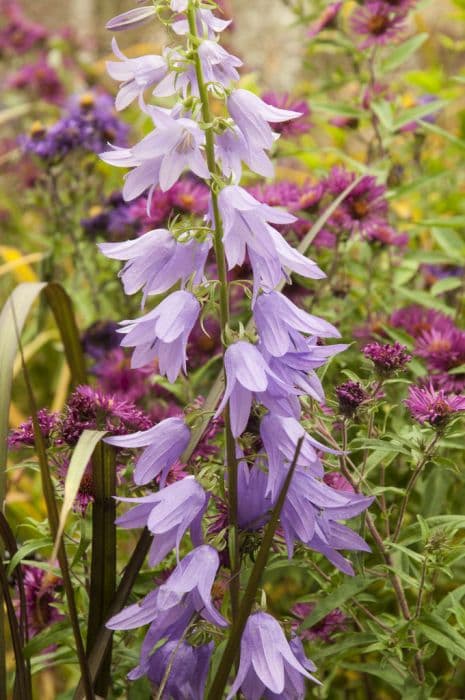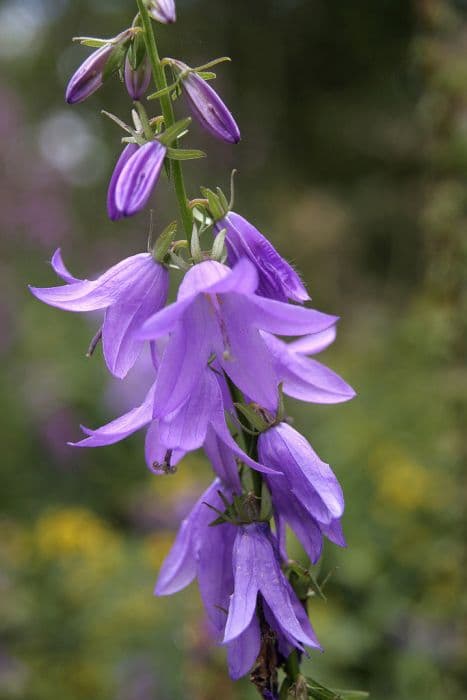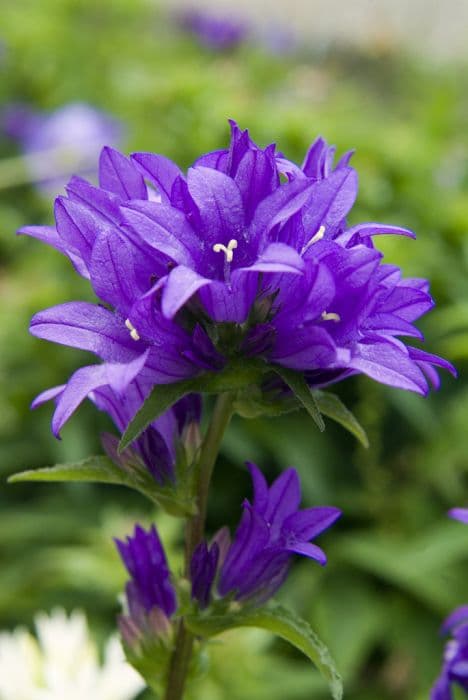Cardinal Flower Lobelia × speciosa 'Fan Scharlach' (Fan Series)

ABOUT
The Lobelia × speciosa 'Fan Scharlach', commonly known as the Cardinal Flower, is a striking perennial with a vibrant display of color. This cultivar is part of the Fan Series, which is known for its richly colored flowers. The Fan Scharlach variety boasts intense scarlet-red blooms that are sure to catch the eye. Each flower is tubular and flared at the mouth, showcasing an intricate structure that can attract hummingbirds and butterflies. The flowers are gathered in dense, elongated clusters atop sturdy stems that rise elegantly above the foliage. These stems are adorned with lance-shaped leaves that have a deep green hue, providing a lush backdrop for the showy blooms. The leaves are typically arranged in a basal rosette at the base of the plant, creating a neat and tidy appearance. The blooming period of the Cardinal Flower extends through the summer months, offering a prolonged period of visual interest in the garden. The appeal of the Fan Scharlach Cardinal Flower is not limited to its flowers alone; the overall structure is an aesthetically pleasing combination of upright growth habit and well-proportioned floral display. This makes it an excellent choice for adding vertical interest to mixed borders, rain gardens, or as a standout specimen in a perennial bed. The intense red of its flowers can also provide dramatic contrast when paired with plants of lighter hues or different textures, making it a versatile plant for various garden designs.
About this plant
 Names
NamesFamily
Campanulaceae
Synonyms
Cardinal Flower, Hybrid Lobelia
Common names
Lobelia × speciosa 'Fan Scharlach' (Fan Series).
 Toxicity
ToxicityTo humans
The plant referred to as Cardinal Flower is mildly toxic to humans if ingested. The compounds responsible for toxicity are lobeline and other pyridine alkaloids found throughout the plant. The symptoms of mild poisoning may include nausea, vomiting, diarrhea, cough, weakness, and an elevated heart rate. In severe cases, more serious symptoms could manifest, such as tremors, dizziness, hypotension, convulsions, and possibly coma. It is advisable to seek medical attention immediately if any parts of the plant are consumed.
To pets
Cardinal Flower is also considered toxic to pets due to the presence of lobeline and related alkaloids. If pets consume any part of the plant, they may exhibit symptoms such as vomiting, diarrhea, excessive drooling, abdominal pain, difficulty breathing, or an accelerated heart rate. Severe cases of poisoning could lead to more serious symptoms, including tremors, seizures, and possibly even coma. If you suspect your pet has ingested Cardinal Flower, contact your veterinarian or an emergency animal clinic right away.
 Characteristics
CharacteristicsLife cycle
Perennials
Foliage type
Deciduous
Color of leaves
Green
Flower color
Red
Height
2-3 feet (60-90 cm)
Spread
1-2 feet (30-60 cm)
Plant type
Herb
Hardiness zones
4-9
Native area
North America
Benefits
 General Benefits
General Benefits- Attracts pollinators: This variety is known to attract bees, butterflies, and other beneficial pollinators, which are crucial for the pollination of many other plants in the garden.
- Easy to grow: Lobelia × speciosa 'Fan Scharlach' is considered to be an easy-to-grow plant that can thrive in a variety of garden conditions with minimal care.
- Long blooming period: It offers a long blooming season, often from midsummer to early fall, providing a long-lasting display of color.
- Versatile in landscaping: This plant can be used in a variety of landscape designs, including borders, containers, and waterside plantings.
- Drought-tolerant: Once established, it is relatively drought-tolerant, making it a good choice for gardens in drier climates or for water-wise gardening.
- Deer resistant: It is known to be resistant to browsing by deer, which can help prevent damage to the plant and maintain a beautiful garden display.
- Vivid color: The plant's intense scarlet flowers add a vibrant pop of color to the garden, which can be used to create striking contrast with other plants.
- Compact habit: The 'Fan Scharlach' has a compact growth habit, which makes it suitable for small gardens or limited spaces without the fear of it overtaking other plants.
 Medical Properties
Medical PropertiesThis plant is not used for medical purposes.
 Air-purifying Qualities
Air-purifying QualitiesThis plant is not specifically known for air purifying qualities.
 Other Uses
Other Uses- Lobelia can be used in cut flower arrangements, adding a vibrant splash of red with its spiky inflorescences.
- As an educational tool in horticulture and botany classes to teach about hybridization and cultivar development, where Lobelia × speciosa 'Fan Scharlach' can serve as an example.
- In butterfly gardens, where the plant's flowers are known to attract butterflies and serve as a nectar source.
- For creating contrasting texture in mixed-media art projects, such as pressing the leaves and flowers into clay or embedding them in resin.
- In photography, using the vivid red flowers as a subject for practicing macro photography techniques.
- As a natural dye, where the flowers could potentially be used to create a range of red hues on fabrics.
- In the creation of natural jewelry, where dried flowers or seed pods can be incorporated into eco-friendly designs.
- To provide color and an organic look in terrariums or fairy gardens, making use of its compact growth habit.
- In culinary presentations, as an ornamental, non-toxic garnish to add color to salads and desserts (note: only if confirmed non-toxic).
- For color-themed garden designs, participating in a red color palette for a garden that follows a specific chromatic scheme.
Interesting Facts
 Feng Shui
Feng ShuiThe Cardinal Flower is not used in Feng Shui practice.
 Zodiac Sign Compitability
Zodiac Sign CompitabilityThe Cardinal Flower is not used in astrology practice.
 Plant Symbolism
Plant Symbolism- Distinctiveness: Lobelia, particularly the Fan Scharlach variety, showcases unique fan-shaped flowers which symbolize its wearer's or owner's distinct and unique qualities.
- Attraction: The bright crimson-red blooms of the Fan Scarlet Lobelia make it a symbol of strong attraction, drawing both admirers and beneficial pollinators in the natural world.
- Vibrancy: The vivid coloring of this plant suggests a symbolism of vibrancy and living life to its fullest.
- Devotion: In the language of flowers, lobelias can represent devotion, possibly due to the intense color and the way the plant is dedicated to growing in specific, often difficult conditions.
 Water
WaterCardinal flowers should be kept consistently moist, especially during their growth period in the spring and summer. Water them thoroughly, allowing the water to soak deep into the soil which encourages deeper roots and a healthier plant. A good rule of thumb is to water every week, providing about 1 inch of water each time. During hot or dry spells, you may need to water twice a week. Adjust the frequency to maintain moist soil, as overwatering can lead to root rot. Be cautious not to let them dry out completely, as this can stress the plant and affect blooming.
 Light
LightCardinal flowers thrive best in partial shade to filtered sunlight. They prefer a spot that is shielded from the intense, direct afternoon sun, which can scorch their leaves and stress the plant. A location that receives morning sunlight and afternoon shade is ideal for promoting vigorous growth and vibrant blooms.
 Temperature
TemperatureCardinal flowers prefer moderate temperatures and will thrive in conditions that range from 60 to 75 degrees Fahrenheit. They can tolerate minimum temperatures down to about 50 degrees Fahrenheit, while maximum temperatures should not exceed 85 degrees Fahrenheit consistently. Protecting these flowers from extreme heat is crucial for their health and flowering.
 Pruning
PruningCardinal flowers should be pruned to encourage fuller growth and more blooms. Deadhead spent flowers regularly to promote additional blooming throughout the season. In late fall, after flowering has finished, cut the plant back to ground level to help prevent disease and prepare it for winter. Pruning is typically needed once the blooming period is over.
 Cleaning
CleaningAs needed
 Soil
SoilCardinal Flower 'Fan Scharlach' thrives in a rich, moist, yet well-draining soil mix with a pH ranging from 6.0 to 7.5, leaning towards slightly acidic to neutral.
 Repotting
RepottingCardinal Flower 'Fan Scharlach' should be repotted every 2-3 years or when it outgrows its pot to maintain vigor and health.
 Humidity & Misting
Humidity & MistingCardinal Flower 'Fan Scharlach' prefers high humidity levels but is adaptable to average room humidity when grown indoors.
 Suitable locations
Suitable locationsIndoor
Place in bright, indirect light with high humidity for best growth.
Outdoor
Plant in partial shade, keep soil moist and protect from strong winds.
Hardiness zone
4-9 USDA
 Life cycle
Life cycleThe perennial plant, commonly known as the Cardinal Flower, begins its life cycle with seed germination in late winter to spring, given moist soil and cool temperatures. The seedlings ultimately develop into a rosette of basal leaves before sending up flowering spikes in late spring to early summer. The striking red flowers bloom throughout the summer, attracting pollinators such as hummingbirds, which are essential for the cross-pollination necessary for seed production. Once pollinated, the flowers produce small fruit capsules containing numerous tiny seeds. In the fall, the plant dies back to the ground after seed dispersal, with the root system remaining dormant through the winter. The Cardinal Flower regenerates from its rootstock the following spring, thereby continuing its life cycle.
 Propogation
PropogationPropogation time
Spring to Summer
The most popular method of propagation for the Lobelia × speciosa 'Fan Scharlach', commonly known as Fan Lobelia, is by seed. Sowing the seeds can be done in early spring under cover, such as in a greenhouse or indoors, as this allows for a longer growing season and protection from late frosts. The seeds are very fine and should be sown on the surface of a well-drained seed starting mix, as they require light to germinate. It is important to keep the soil consistently moist but not waterlogged, and maintaining a temperature of about 70-75 degrees Fahrenheit (around 21-24 degrees Celsius) will provide an optimal environment for germination. Seedlings usually appear in 14 to 21 days, after which they should be gradually acclimatized to outdoor conditions before planting out after all risk of frost has passed.









